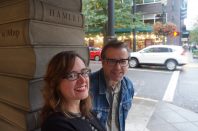
Gigi Little and Kevin Sampsell
When I edited the collection City of Weird: 30 Otherworldly Portland Tales for Forest Avenue Press, I got to do something really fun: publish a writer who once published me. Kevin Sampsell (This is Between Us, and A Common Pornography) edited the anthology Portland Noir (Akashic) in 2009. It was a super cool collection—all noir stories set in Portland—and my first short story publication ever. Like Portland Noir, the stories in City of Weird all take place in, or have a very meaningful connection to, Portland, but rather than noir, they are all focused on the realm of “weird fiction,” that subgenre of speculative fiction that focuses on a blending of supernatural, mythical, and scientific tropes. Kevin’s story, “In Transit,” is made up of a beautifully weird series of vignettes that take place on Portland trains and buses.
Kevin and I both also work for the country’s biggest independent bookstore, Powell’s Books, and share a love for all things indy and small press. With City of Weird now in its third printing and doing well (it’s a Pacific Northwest Independent Bookseller bestseller), I thought it would be fun for him to interview me and for me to interview him right back, about our respective projects and literary loves…
-Gigi Little
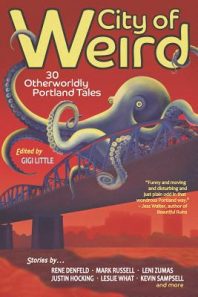 GIGI: You edited a book I wrote a story for (Portland Noir) and I edited a book you wrote a story for (City of Weird). I think that makes us brother and sister, now. Would you submit to a blood ritual in honor of this literary siblingship, and what kind of cake do you think we should have for the official afterparty?
GIGI: You edited a book I wrote a story for (Portland Noir) and I edited a book you wrote a story for (City of Weird). I think that makes us brother and sister, now. Would you submit to a blood ritual in honor of this literary siblingship, and what kind of cake do you think we should have for the official afterparty?
KEVIN: Acknowledging our siblingness is bound to cause little squabbles. I have no idea what kind of cake you like, but I fear that it’ll be something with coconut, which feels too hairy to me. Like I’m eating a plastic wig or something. I like pretty traditional cake flavors: lemon, chocolate, vanilla. I think I actually prefer brownies to cake.
KEVIN: Do you think Portland will get weirder in the next five years or do you think it has leveled off?
GIGI: I feel like maybe its weirdness has plateaued. We used to be weird in our own right and then we started becoming aware of and promoting our weirdness, and that made us want to be weirder, and then the show came along and made that weirdness even more self-aware, and at some point all that conscious weirdness-seeking makes the actual weirdness break down. I think maybe we’ll get less weird for a while until our natural weirdness can surface again on its own.
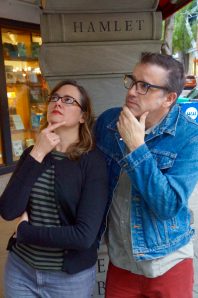 GIGI: What do you think about the “weird” of Portland? The word “weird” can have positive or negative connotations. What do you think of primarily when you think of the word “weird”?
GIGI: What do you think about the “weird” of Portland? The word “weird” can have positive or negative connotations. What do you think of primarily when you think of the word “weird”?
KEVIN: I think “weird” is for weirdos. I cringe a little when “normal” people use the word. It’s like when punk and rap music began to seep into television commercials. It was kind of embarrassing. “Weird” isn’t for everyone. It doesn’t belong in the mainstream and that’s why it’s special. I’m glad when things are truly weird, not forcefully weird. I like it when weird people don’t realize they’re weird. That’s how you know they’re authentically weird.
KEVIN: What stories in City of Weird do you think may actually be rooted in truth?
GIGI: Oh, well I know for sure that Doug Chase’s story, “Squatty and Weasel Boy,” about the ghost of a homeless man who haunts a Burger King, has some roots in truth. A homeless man actually was killed once in the industrial trash compactor behind the Burger King on Burnside and Broadway in the Northwest, as the story describes, and there was also an urban legend that that Burger King was haunted. I’ve been told a lot of the characters in Sean Davis’ story “The Fixer,” including the Bigfoot character and the street prophet, are real people. Kevin Meyer’s “Out of Order” is rooted in truth just in the fact that the Polybius story (a 1980s-era video game that supposedly caused psychoactive effects like amnesia and Polybius-addiction in its players and was accompanied by mysterious men in black) is an actual urban legend that originated in Portland. In “Out of Order,” Kevin essentially writes a sequel to that myth.
GIGI: How about the vignettes in your story “In Transit”? Like the guy whose coat got snagged in the back door of the bus or the April Fools’ Day joke. Any of those, or other, stories in there rooted in truth?
KEVIN: I did once hear a story about that happening to someone. And they did get some kind of settlement from Trimet. I think my story is probably half-fiction. The part about the guy telling me not to look at him is true. The April Fools thing was made-up. All the pedestrian killing is somewhat made up (ha ha). Many of the details are true though, like you always see empty cans rolling around under the seats annoyingly.
KEVIN: If one of the stories in City of Weird was to be made into a movie, which one would you want to see most?
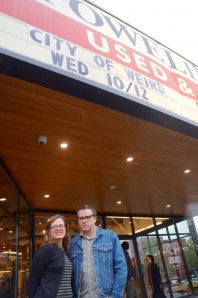 GIGI: Hmm, hmm, hmmmmmm. I have a hard time in picking bests and mosts and favorites in the collection. Frankly, if we were talking a short film, I’d love to see yours. I think “In Transit” would make a fantastic short film if put in the right hands. Something edgy and funny and weird and surprising. It would be a wonderful structure for a filmmaker to explore: these short snippets of story, little glimpses of moments on Portland buses and trains, all strung together with the thread of the relentless movement on the road and on the tracks. And those snippets of story—they all seem disparate and random, but what we get in the end is this beautiful commentary on our separateness as people in the world.
GIGI: Hmm, hmm, hmmmmmm. I have a hard time in picking bests and mosts and favorites in the collection. Frankly, if we were talking a short film, I’d love to see yours. I think “In Transit” would make a fantastic short film if put in the right hands. Something edgy and funny and weird and surprising. It would be a wonderful structure for a filmmaker to explore: these short snippets of story, little glimpses of moments on Portland buses and trains, all strung together with the thread of the relentless movement on the road and on the tracks. And those snippets of story—they all seem disparate and random, but what we get in the end is this beautiful commentary on our separateness as people in the world.
It’s hard to take a short story and envision a full-blown feature film, but if I did that, the first one I’d picture is Stevan Allred’s “Notes from the Underground City,” because it’s epic in scope. I mean, the thing starts with a 500-plus year old wizard shrinking pockets of Portland down into a miniature city somewhere deep in the Shanghai Tunnels, and it ends on the verge of a giant, although, OK, small-of-stature, revolution.
Bonus answer: I’d love to see Brigitte Winter’s “Octopocalypse” done up as an old “Twilight Zone” episode. I don’t know what Rod Serling would do with the lesbian love story, but I can totally see that man-eating octopus done up in 1950s black and white and it has the perfect “Twilight Zone” twist of an ending.
GIGI: If your story in particular was to be made into a movie, who do you see playing your narrator and who would you want to direct it?
KEVIN: I’ve been loving that Black Mirror show. I like the menacing tone of it. I’d love to see Charlie Brooker make that into something. And how about Clive Owen as the mild-mannered bus/train rider? That’s fun to think about.
KEVIN: As a bookseller, sometimes people ask for “something really weird.” What did you recommend to people when customers asked you that?
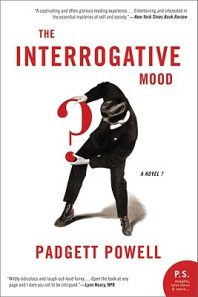 GIGI: Oh, god, good question. I remember recommending Padgett Powell’s The Interrogative Mood to a customer who asked that exact question. I like the nerdiness of writing a novel all in questions, and as weird as that is, the book never felt gimmicky to me. For classic and weird (and brilliant) I like Slaughterhouse Five. My favorite weird is the deadpan kind, that simply lays the oddities out as if they aren’t odd at all, and that’s part of what makes Vonnegut’s voice so engaging to me. Your story in City of Weird totally does that, and that’s one of the things I love about it. But often when I got a question like that, I would direct folks to the Small Press section and talk about how much different weird and wonderful stuff you can find in there. The fact that these books aren’t ground through the engine of the Big Five means there’s so much more peculiarity and particularity that can come through. In fact:
GIGI: Oh, god, good question. I remember recommending Padgett Powell’s The Interrogative Mood to a customer who asked that exact question. I like the nerdiness of writing a novel all in questions, and as weird as that is, the book never felt gimmicky to me. For classic and weird (and brilliant) I like Slaughterhouse Five. My favorite weird is the deadpan kind, that simply lays the oddities out as if they aren’t odd at all, and that’s part of what makes Vonnegut’s voice so engaging to me. Your story in City of Weird totally does that, and that’s one of the things I love about it. But often when I got a question like that, I would direct folks to the Small Press section and talk about how much different weird and wonderful stuff you can find in there. The fact that these books aren’t ground through the engine of the Big Five means there’s so much more peculiarity and particularity that can come through. In fact:
GIGI: As curator of the Small Press section at Powell’s City of Books, what are some “weird” books that you would recommend, particularly published by small presses?
KEVIN: Ha! Yes. The small press section has the bounty of weird stuff, for sure. But props to HarperCollins for publishing that Padgett Powell book, which I also love. Some of my favorites to recommend in small press are Letters to Wendy’s by Joe Wenderoth, which is genius. Wenderoth is a poet and this book of short comment card-size prose pieces is dirty, philosophical, and bizarrely funny. I love recommending the books of Jennifer L. Knox, Chelsea Martin, and James Gendron, too—all beautiful weirdos. Oh—and Mark Leyner, Judy Budnitz, the late great Russell Edson, and the early work of Ben Marcus.
KEVIN: As a bookstore person, what do you think you learned from your publisher, and vice versa?
GIGI: I have learned so much from Laura Stanfill [publisher of Forest Avenue Press]. Perseverance is one of the big ones. As a bookstore employee, seeing how incredibly difficult it is for publishers to keep their heads above water seeing how quickly books come and go, how many books are out there, how much competition… ugh, it’s enough to make you vow you’ll never try to be a writer, much less a publisher, putting your own money on the line. But Laura is out there every day pushing and creating and risking. She has guts and she has perseverance—and most of all passion. She doesn’t just decide she’d like to publish a book; she has to fall in love with it first. And as for what she’s learned from me in my capacity as a bookseller… I don’t know. Maybe how much that love goes both ways. How passionate booksellers can be. I think we’re all in a lucky place. As booksellers, writers, editors, and publishers—we share a unique passion for books.
GIGI: You are an accomplished collage artist as well as writer. This doesn’t surprise me as your writing is made up of small clippings of moments arranged in artful ways. Do you draw a parallel between your writing and your art and why do you think you tend to organize your writing this way?
KEVIN: Yeah, it’s funny. My writing wasn’t always fragmented like that. But I think it’s more life-like sometimes to write in these shifting chunks and small moments. Life is rarely linear. And I also think that I’ve been influenced by the fluidity of poetry in recent years. I love writing like that and I feel like the sense of discovery I get from working on collages is similar. But they are pretty different things for me. Writing is mostly my brain. Collaging is mostly my eyes. Any link between the two is not intentional but I guess it’s not surprising. I can be weird in both.
KEVIN: Were there any places written about in City of Weird that you now have a different point of view on? Like some place that might be more messed up than you think?
GIGI: Hmm, I guess I just feel like I have a better sense of Portland in general now than I had before. I’ve lived here ten years but most of what I knew was the Northwest, and a pretty small chunk of the Northwest at that. Like I never knew a thing about Portland’s “floating home” areas along the water (described in Leslie What’s “Trainwreck”). That feels like a whole subculture I hadn’t heard of. I knew nothing about Reed College before, and that whole Reed College Canyon they have there. There are so many odd areas in Portland and it was super fun to “explore” these areas through people’s stories.



Squatty is amazing—you Powell’s folks! Kevin, my favorite line from your piece:
I thought about eating the banana. Would that frighten the boy or please him?”